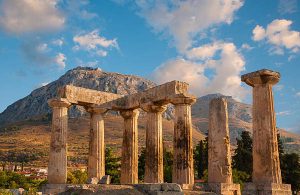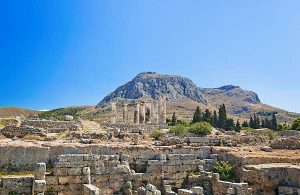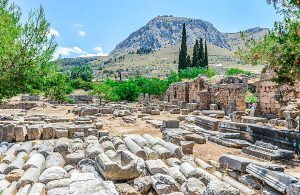Archaeological Site of Ancient Corinth
 Ancient Corinth located on the narrow stretch of land known as the Isthmus of Corinth, the city occupied a pivotal position that connected the Peloponnese to the mainland of Greece. This location was of immense strategic importance, as it controlled the land route between Athens and the Peloponnese and was near the Corinthian Gulf, facilitating trade routes between the Aegean and Ionian seas. The ancient city also benefited from its proximity to the Acrocorinth, a towering rocky outcrop that provided a natural fortress and a sanctuary for its patron goddess, Aphrodite.
Ancient Corinth located on the narrow stretch of land known as the Isthmus of Corinth, the city occupied a pivotal position that connected the Peloponnese to the mainland of Greece. This location was of immense strategic importance, as it controlled the land route between Athens and the Peloponnese and was near the Corinthian Gulf, facilitating trade routes between the Aegean and Ionian seas. The ancient city also benefited from its proximity to the Acrocorinth, a towering rocky outcrop that provided a natural fortress and a sanctuary for its patron goddess, Aphrodite.
Ancient Corinth, once a powerful city-state in the Peloponnese peninsula of Greece, stands as a testament to the enduring legacy of Greek civilization. This city, which flourished in antiquity, was a major player in both the Greek and Roman periods, known for its strategic location, economic prosperity, and cultural achievements. Its ruins serve as a reminder of the city’s significant role in shaping the history of Greece and the wider Mediterranean world.
As a center of trade, culture, and politics, Corinth was a linchpin in the ancient world, whose influence is still appreciated in the fields of archaeology, history, and architecture today.
Historical Overview
 The history of Ancient Corinth can be divided into several key periods: the Greek, the Roman, and the Byzantine eras. Initially, during the 8th century BCE, Corinth became one of the leading powers of the Greek world, thanks to its thriving economy, advanced engineering, and a powerful navy. The city was renowned for its pottery and metalwork, with Corinthian products being exported across the Mediterranean.
The history of Ancient Corinth can be divided into several key periods: the Greek, the Roman, and the Byzantine eras. Initially, during the 8th century BCE, Corinth became one of the leading powers of the Greek world, thanks to its thriving economy, advanced engineering, and a powerful navy. The city was renowned for its pottery and metalwork, with Corinthian products being exported across the Mediterranean.
In 146 BCE, Corinth was conquered by the Roman Republic, marking the end of its independence. The Romans demolished the city but later rebuilt it in 44 BCE, making it the provincial capital of Achaia. Under Roman rule, Corinth regained its former glory, becoming one of the wealthiest cities in the Roman Empire, famous for its architectural feats and cultural life.
Economic Prosperity
The wealth of Ancient Corinth was largely derived from trade. Its strategic location facilitated its emergence as a major commercial hub, where goods from all over the Mediterranean were exchanged. The city was especially known for the diolkos, a paved trackway that allowed ships to be transported overland across the Isthmus of Corinth, saving time and avoiding dangerous sea routes.
 Corinth was also famous for its production of “Corinthian bronze,” a highly prized alloy, and the invention of the Corinthian order, one of the classical orders of ancient Greek and Roman architecture, characterized by ornate capitals decorated with acanthus leaves.
Corinth was also famous for its production of “Corinthian bronze,” a highly prized alloy, and the invention of the Corinthian order, one of the classical orders of ancient Greek and Roman architecture, characterized by ornate capitals decorated with acanthus leaves.
Culturally, Corinth was a melting pot of Greek and foreign deities, with temples dedicated to Apollo, Poseidon, and, most notably, Aphrodite. The Temple of Apollo, one of the oldest Doric temples in Greece, reflects the city’s architectural heritage. According to ancient sources, the Temple of Aphrodite housed a significant number of sacred prostitutes, an assertion that has been debated by modern scholars.
The Isthmian Games, second only to the Olympic Games in fame, were hosted by Corinth. These pan-Hellenic games, held in honor of Poseidon, featured athletic competitions, chariot races, and cultural events, drawing visitors from across the Greek world.
Archaeological Significance
The archaeological significance of Ancient Corinth lies in its rich history, which spans several millennia, and its role as a major power in the ancient Greek and Roman worlds. The site provides invaluable insights into ancient urban planning, architecture, and social life. Excavations have unearthed a wealth of artifacts and structures that reflect the city’s prosperity, cultural diversity, and technological advancements.
Urban Planning and Infrastructure
Ancient Corinth was renowned for its sophisticated urban planning and infrastructure. The city’s layout, with its well-organized streets, public squares, and buildings, showcases the advanced level of urban development achieved by the Greeks and later enhanced by the Romans. Notable is the Peirene Fountain, an intricate system of springs and aqueducts that provided water to the city, demonstrating the ancient engineers’ ability to harness natural resources for urban use.
The archaeological site of Corinth is home to significant architectural innovations, including the Temple of Apollo, one of the earliest Doric temples in Greece. The ruins of this temple, with its monolithic columns, offer insights into the development of Greek temple architecture. Additionally, Roman Corinth contributed to architectural heritage with structures like the Bema, where St. Paul is said to have been judged, reflecting the integration of political and social life.
The remains of shops, workshops, and the Agora (central marketplace) in Corinth illustrate the city’s bustling economic life. The discovery of numerous artifacts related to trade, such as pottery, terracotta lamps, and coins, alongside luxury items like jewelry and fine tableware, indicates Corinth’s role as a major trading hub. The city’s economy was also bolstered by its control over the diolkos, an overland route that allowed for the transport of ships and goods across the Isthmus of Corinth, serving as a precursor to the modern Corinth Canal.
Corinth’s religious and cultural life is evidenced by the remnants of temples dedicated to various deities, such as Aphrodite, Apollo, and Poseidon. The large theater and odeon found in the city attest to Corinth’s vibrant cultural scene, where music, drama, and public speeches were an integral part of civic life. The archaeological evidence of diverse religious practices, including temples and altars, highlights the city’s multicultural environment, where Greek, Roman, and Eastern deities were worshipped.
How to get to Ancient Corinth from Athens
Traveling from Athens to Ancient Corinth is a straightforward journey that can be enjoyed through various modes of transportation, offering a glimpse into the rich historical tapestry of Greece. Here’s how you can make the trip:
By Car
- Route: The most direct route is via the A8/E94 highway, which is part of the Olympia Odos.
- Distance and Travel Time: The distance is approximately 85 kilometers (about 53 miles), and the drive usually takes around 1 hour and 15 minutes, depending on traffic.
- Directions: From Athens, follow the signs towards Elefsina, and continue on the A8/E94 towards Corinth. You’ll exit the highway just before the Corinth Canal, following the signs to Ancient Corinth (Archaia Korinthos).
- Tolls: Be prepared for tolls on the A8/E94 highway.
By Bus
- Service Provider: KTEL buses operate regular services between Athens and Corinth.
- Departure Point in Athens: Buses depart from the Kifissos Bus Terminal (KTEL Kifisou).
- Travel Time: The journey takes approximately 1 hour and 30 minutes.
- Arrival Point: You will arrive at the Corinth bus station. From there, you can take a local bus or a taxi to reach Ancient Corinth, which is about 7 kilometers (4.3 miles) from modern Corinth city center.
By Train
- Service Provider: Hellenic Railways Organization (OSE) provides train services from Athens to Corinth.
- Departure Point in Athens: Trains depart from Athens Railway Station (Larissa Station).
- Travel Time: The train journey takes about 1 hour to Corinth station.
- Note: From the Corinth train station, you’ll need to take a taxi or a local bus to reach Ancient Corinth, as the train station is located in the modern part of the city, about 7 kilometers from the archaeological site.
By Organized Tour
- Option: Many travel agencies in Athens offer day trips to Ancient Corinth, which include transportation and a guided tour of the site.
- Benefits: This is a convenient option if you prefer not to navigate public transportation or rent a car. It also provides the added value of a knowledgeable guide.
Tips for Your Visit
- Best Time to Visit: Spring (April to June) and autumn (September to November) are ideal as the weather is more pleasant and the sites are less crowded.
- Facilities: Ancient Corinth has a small museum on-site, where you can see artifacts uncovered during excavations. There are also restrooms and a small café.
- Stay Hydrated: Especially during the summer months, it’s important to carry water with you as it can get quite hot.
Whichever mode of transportation you choose, visiting Ancient Corinth from Athens is an enriching experience that offers insights into the ancient world, set against the backdrop of Greece’s stunning landscapes.
